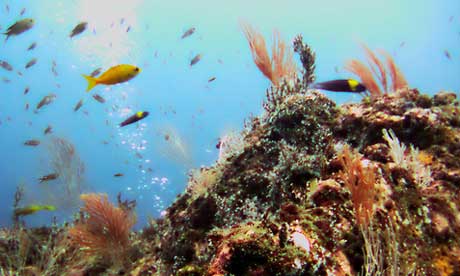
Sarah Barrell goes diving on Colombia's coral coast with shoals of angel, butterfly and Jewfish, along with barracuda, manta rays and a baby hammerhead shark
At a distance you’re not sure they are there. Like a child’s drawing of a desert island, most of the 30 islets that make up the Islas del Rosario are no more than a tiny hump of land poking up out of the turquoise water, topped with a palm tree and, perhaps, a little house.
But as the boat edges closer to land, navigating some of Colombia’s most spectacular coral in gently decreasing arcs, you realise that this isn’t some briny hallucination, the result of two hours spent bouncing across the top of the glaring Caribbean in the back of a speed boat; the islands really are there, and they really are that pint-sized and picture perfect.
The Archipelago of Nuestra Señora del Rosario, known as the Rosario Islands, is located 45km offshore from Cartagena, on the northern Colombian coast. Declared a marine national park in 1977 (one of three in Colombia; comprising of 120,000 hectares) the islands have become something of a refuge for divers, marine researchers, and refuge-seeking South Americans.
While docking we pass the holiday home of Colombian ex-president Turbay; sitting on its own island, this sleek, modern construction is distinct from the palm-thatched houses that characterise most of Rosario’s residences. We, however, like most visitors, are heading for the ocenario at Isla San Martín.
As aquariums go, San Martín’s must be a contender for the world’s most idyllic; taking up the whole island and its surrounding sea pens; the star residents are a number of bottlenose and pink-bellied sotalia dolphins, common to the mangroves and northern coast of South America. Two or three times a day, tourist boats visit the aquarium, delivering crowds of holidaying Colombians, signalling the start of a presentation in rapid-fire Spanish and some impressive acrobatics from the dolphins. Other than that, the island is still.
Rough afternoon sea crossings dictate that trips from the mainland depart early morning. Do the rounds of the islands before stopping off at Playa Blanca on Isla de Barú for lunch and San Martín, returning to the mainland by about 3pm. Unless you somehow wangle your way into a private home, there are only five places for overnight stays, so book ahead.
Other than seasonal tourist workers, most residents are fishermen, seen making their morning rounds of the yacht anchorages, selling papayas and fish caught in their atarrayas‚ (round nets typical in this part of the Colombian Caribbean). One year-round resident and fisherman of a different kind, is Rafael Vieira-Obregon, owner of San Martín’s aquarium.
Born on the mainland, in Barranquilla, ‘Rafa’ came to San Martín 28 years ago; never out of swimming trunks, even at the dinner table, and with shoulder length blonde hair as wild as a marine plant, he looks as if he was born and raised in the coral. “When I arrived here, Colombians did not know about Rosario,” he says. “There were no more than about six houses here then.” After spending his university years in London, Rafa returned to the islands and set about building the aquarium. He has barely left since.
Alongside the government and national park authorities Rafa works to monitor and protect the islands’ marine life. He takes me for a swim out into the coral, knowing exactly where to seek out rainbow shoals of angel, butterfly and Jewfish, along with barracuda, manta rays and, not a little alarmingly, a baby hammerhead shark. Back in the aquarium the guide is performing for the crowds; thumping the side of the platform he calls each of the tiburones gatos‚ (cat- or nurse-sharks) by name and they come and take the food from his hand, happy as tail-wagging labradors.
Docile as they seem, Rafa thankfully leaves the sharks to their chum, suggesting instead that we hop into the dolphin tank. Most of these dolphins, such as Stephania, a female bottlenose who comes to playfully nudge me the instant I’m in the water, are being rehabilitated in the hope that they will return to the wild.
Stephania was bought from an aquarium in San Andrés (Colombia) in 1998, where she was deteriorating in a concrete tank. Due to the conditions under which she had previously been kept, it’s unlikely she will ever be released, but here, with other dolphins like her, she lives in sea pens with open gates allowing free range of the ocean. Swimming alongside Stephania, gazing out at the little islands dotted like stepping stones around us, it seemed easy to see why, even with the gates open, the dolphins always end up coming back.